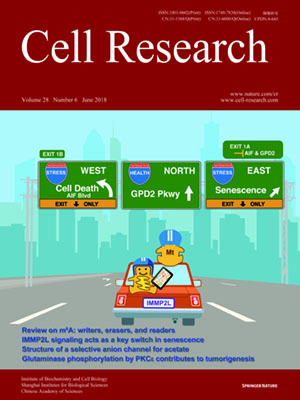
Volume 28, No 6, Jun 2018
ISSN: 1001-0602
EISSN: 1748-7838 2018
impact factor 17.848*
(Clarivate Analytics, 2019)
Volume 28 Issue 6, June 2018: 655-669
ORIGINAL ARTICLES
Phosphorylation of glutaminase by PKCε is essential for its enzymatic activity and critically contributes to tumorigenesis
Tianyu Han 1,2, Weihua Zhan 1,2, Mingxi Gan 1, Fanrong Liu 3, Bentong Yu 4, Y. Eugene Chin 5 and Jian-Bin Wang 1
1 Institute of Translational Medicine, Nanchang University, Nanchang City, Jiangxi 330031, China; 2School of Life Sciences, Nanchang University, Nanchang City, Jiangxi 330031,
China; 3Department of Pathology, The Second Affiliated Hospital of Nanchang University, Nanchang City, Jiangxi 330006, China; 4Department of Cardiovascular Surgery, The First
Affiliated Hospital of Nanchang University, Nanchang City, Jiangxi 330006, China and 5Institute of Health Sciences, Chinese Academy of Sciences at Shanghai, Shanghai 200025,China
Correspondence: Jian-Bin Wang (jianbinwang1@gmail.com)
Glutamine metabolism plays an important role in cancer development and progression. Glutaminase C (GAC), the first enzyme in glutaminolysis, has emerged as an important target for cancer therapy and many studies have focused on the mechanism of enhanced GAC expression in cancer cells. However, little is known about the post-translational modification of GAC. Here, we report that phosphorylation is a crucial post-translational modification of GAC, which is responsible for the higher glutaminase activity in lung tumor tissues and cancer cells. We identify the key Ser314 phosphorylation site on GAC that is regulated by the NF-κB-PKCε axis. Blocking Ser314 phosphorylation by the S314A mutation in lung cancer cells inhibits the glutaminase activity, triggers genetic reprogramming, and alleviates tumor malignancy. Furthermore, we find that a high level of GAC phosphorylation correlates with poor survival rate of lung cancer patients. These findings highlight a previously unappreciated mechanism for activation of GAC by phosphorylation and demonstrate that targeting glutaminase activity can inhibit oncogenic transformation.
10.1038/s41422-018-0021-y
FULL TEXT | PDF
Browse 1183


